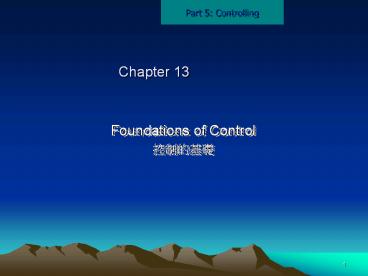Foundations of Control - PowerPoint PPT Presentation
1 / 23
Title:
Foundations of Control
Description:
Title: Fundamentals of Management 4e. - Robbins and DeCenzo Subject: Chapter 13 Author: Charlie Cook, University of West Alabama Last modified by – PowerPoint PPT presentation
Number of Views:70
Avg rating:3.0/5.0
Title: Foundations of Control
1
Chapter 13
- Foundations of Control
- ?????
2
OUTLINE S
- Define control.
- Three approaches to control.
- The control process.
- Three types of control.
- Qualities of an effective control system.
- Contingency factors in the control process.
- How controls can become dysfunctional.
- How an entrepreneur controls for growth.
3
What Is Control?
- Control
- The process of monitoring activities to ensure
that they are being accomplished as planned and
of correcting any significant deviations - ????????????????????????????
- An effective control system ensures that
activities are completed in ways that lead to the
attainment of the organizations goals.
4
Three Approaches to Control Systems
- Market????
- Uses external market mechanisms, such as price
competition and relative market share, to
establish standards used in system to gain
competitive advantage. ????????????????,??????????
??? - Bureaucratic??????
- Emphasizes organizational authority of
administrative and hierarchical mechanisms to
ensure appropriate employee behaviors and to meet
performance standards.????????????,???????????????
???????? - Clan????
- Regulates employee behavior by the shared values,
norms, traditions, rituals, beliefs, and other
aspects of the organizations culture.????????????
??????????????????????????????????
5
The Control Process ????
???????
??????
??
??
????
????
6
Steps in the Control Process (No.1)
- Measuring actual performance??????
- Personal observation, statistical reports, oral
reports, and written reports??????????????????????
?? - Management by walking around (MBWA)?????
- A phrase used to describe when a manager is out
in the work area interacting with employees
7
Steps in the Control Process (No.2)
- Comparing actual performance against a
standard??????????? - Comparison to objective measures budgets,
standards, goals - Range of variation????
- The acceptable parameters of variance between
actual performance and the standard
8
Defining an Acceptable Range of Variation
????
????????
????
EXHIBIT 13.3
9
Steps in the Control Process (No.3)
- Taking managerial action to correct deviations or
inadequate standards????????????????? - Correct actual performance????
- Immediate corrective action??????Correcting a
problem at once to get performance back on
track???????????? - Basic corrective action??????Determining how and
why performance has deviated and then correcting
the source of deviation?????????????,?????????????
- Revising the standard????
- Adjusting the performance standard to reflect
current and predicted future performance
capabilities
10
Mid-Western Distributors Sales Performance for
July (hundreds of cases)
BRAND STANDARD ACTUAL OVER (UNDER) Heineken 1,075
913 (162) Molson 630 634 4 Becks 800 912 112 Moo
sehead 620 622 2 Labatts 540 672 132 Corona 160 1
40 (20) Amstel Light 225 220 (5) Dos
Equis 80 65 (15) Tecate 170 286 116 Total
cases 4,300 4,464 164
EXHIBIT 13.4
11
Types Of Control
- Feedforward control????
- Control that prevents anticipated
problems??????????? - Concurrent control??????
- Control that takes place while an activity is in
progress?????????? - Feedback control??(??)??
- Control that takes place after an action?????????
- Provides evidence of planning effectiveness
- Provides motivational information to employees
12
Types of Control
13
Steps in Performance Feedback
14
Qualities Of An Effective Control System
- ???
- ???
- ??
- ??
- ????
- ?????
- ??????
- ????
- ????
- ????
- Accuracy
- Timeliness
- Economy
- Flexibility
- Understandability
- Reasonable criteria
- Strategic placement
- Emphasis on the exception
- Multiple criteria
- Corrective action
15
Contingency Factors???? in the Design of Control
Systems
16
(No Transcript)
17
Controls And Cultural Differences???????
- Methods of controlling employee behavior and
operations can be quite different in different
countries. - Distance creates a tendency for formalized
controls in the form of extensive, formal
reports. - In less technologically advanced countries,
direct supervision and highly centralized
decision making are the basic means of control. - Local laws constraint the corrective actions that
managers can take foreign countries.
18
The Dysfunctional Side Of Control??????
- unfocused controls
- Failure to achieve desired or intended results
occur when control measures lack specificity - incomplete control measures
- Individuals or organizational units attempt to
look good exclusively on control measures. - inflexible or unreasonable control standards
- Controls and organizational goals will be ignored
or manipulated.
19
Control Measures for Deterring Employee Theft or
Fraud
20
Contemporary Issues In Control???????
- The right to personal privacy in the workplace
versus - Employers monitoring of employee activities in
the workplace - Employers liability for employees creating a
hostile environment - Employers need to protect intellectual property
- Remember The computer on your desk belongs to
the company
21
How An Entrepreneur Can Control For Growth
- Planning for growth
- By addressing growth strategies as part of
business planning but not being overly rigid in
planning. - Organizing for growth
- The key challenges include finding capital,
finding people, and strengthening the
organizational culture. - Controlling for growth.
- Maintaining good financial records and financial
controls over cash flow, inventory, customer
data, sales orders, receivables, payables, and
costs.
22
Suggestions for Achieving a Supportive
Growth-Oriented Culture
- Keep the lines of communication openinform
employees about major issues. - Establish trust by being honest, open, and
forthright about the challenges and rewards of
being a growing organization. - Be a good listenerfind out what employees are
thinking and facing. - Be willing to delegate duties.
- Be flexiblebe willing to change your plans if
necessary.
EXHIBIT 13.8a
23
Suggestions for Achieving a Supportive
Growth-Oriented Culture (contd)
- Provide consistent and regular feedback by
letting employees know the outcomesgood and bad. - Reinforce the contributions of each person by
recognizing employees efforts. - Continually train employees to enhance their
capabilities and skills. - Maintain the focus on the ventures mission even
as it grows. - Establish and reinforce a we spirit since a
successful growing venture takes the coordinated
efforts of all the employees.
EXHIBIT 13.8b































